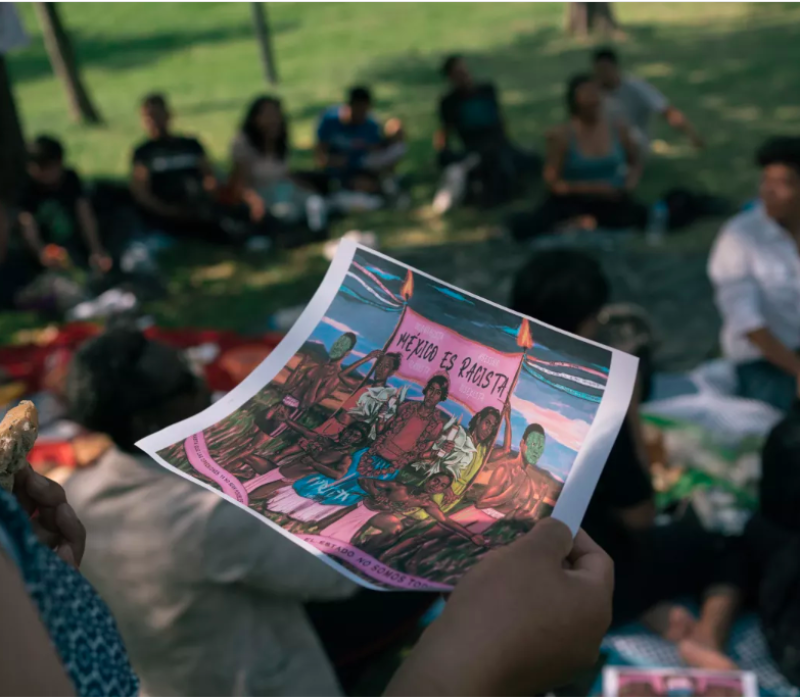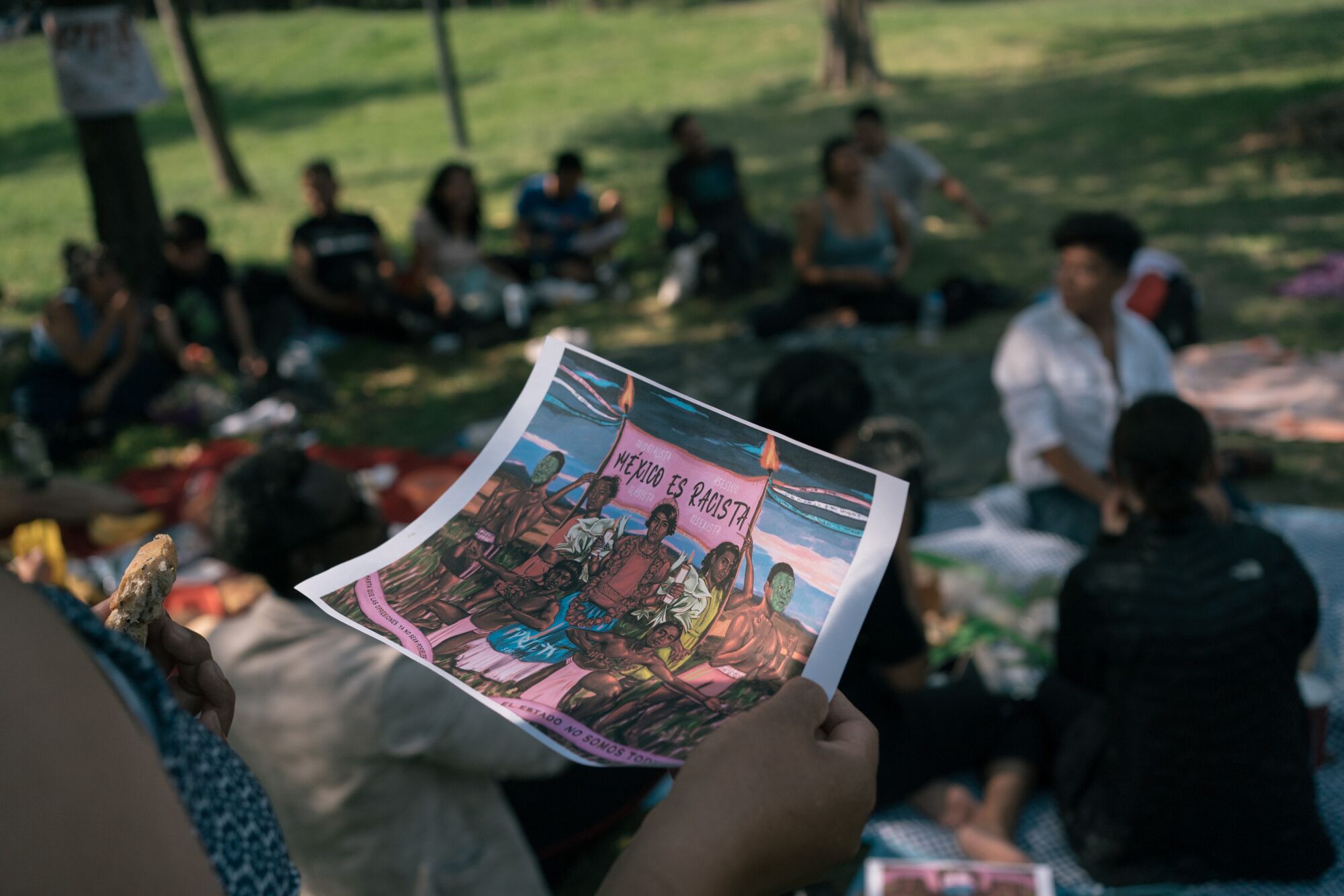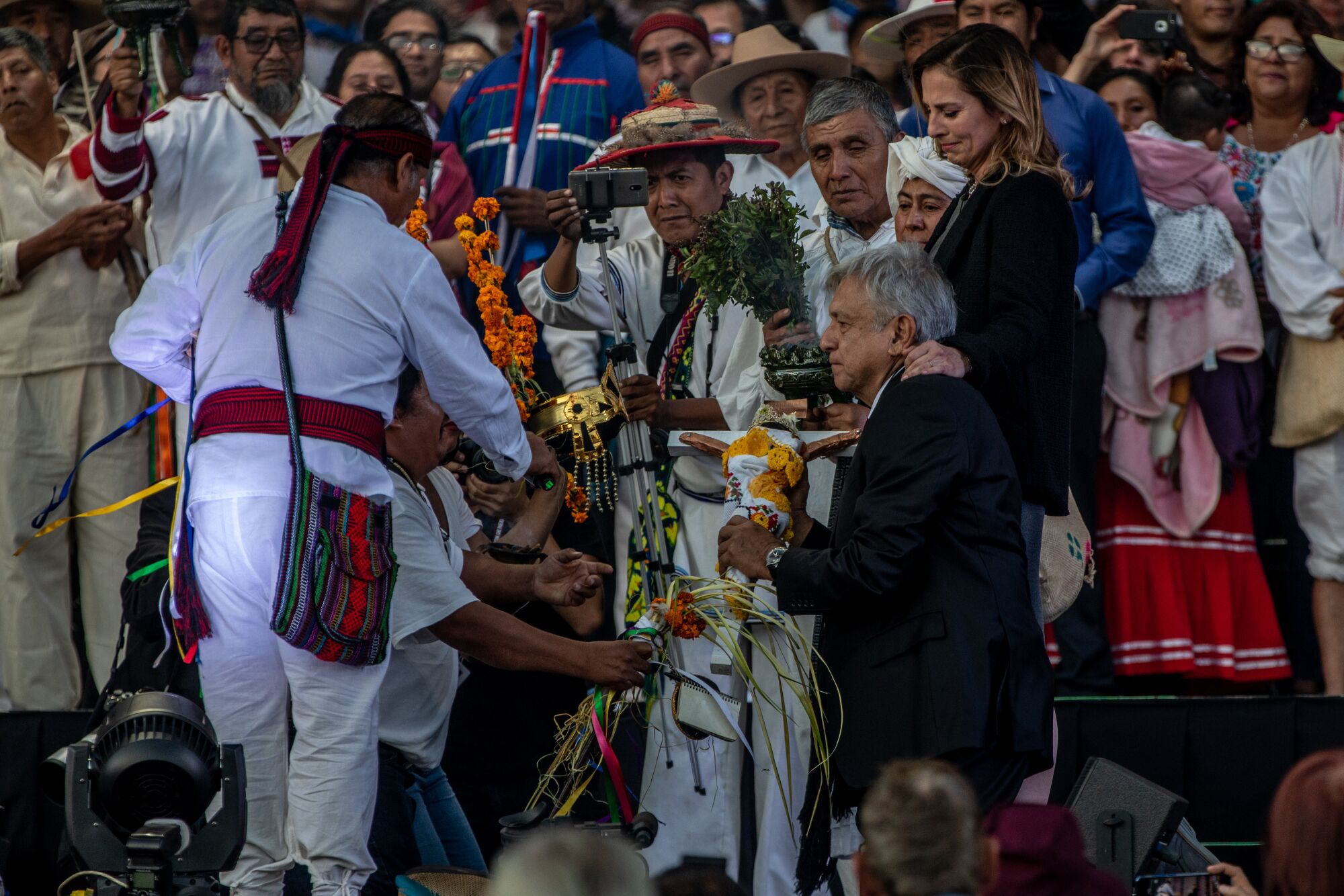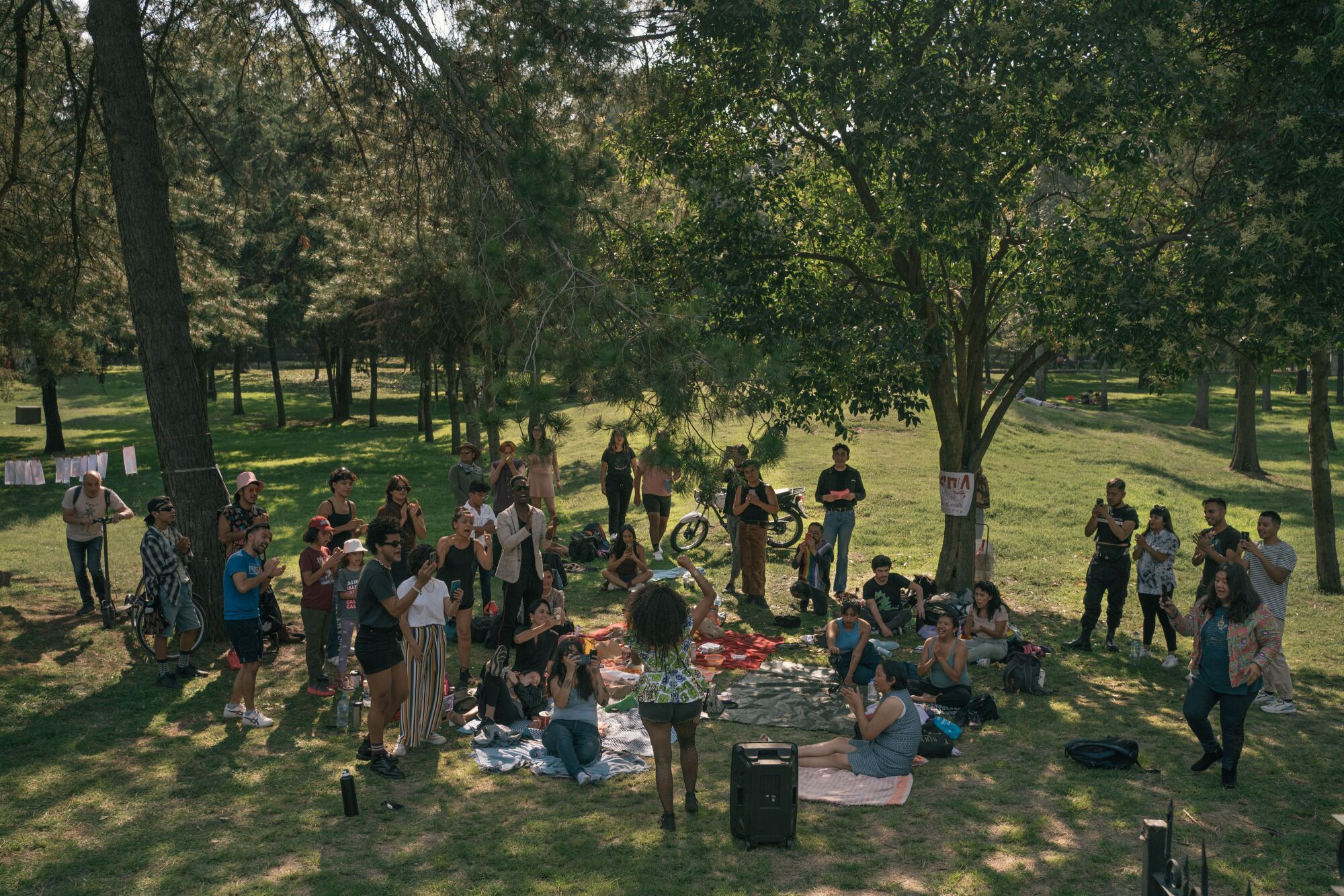An anti-racism movement protests colorism in Mexico - The San Diego Union-Tribune
Category: News & Politics
Via: kavika • 2 years ago • 20 commentsBy: Kate Linthicum (San Diego Union-Tribune)



A few months ago, several employees of an upscale Mexico City steakhouse came forward with a damning allegation: The restaurant had a policy of segregation in which the best tables were reserved for the customers with the lightest skin.
The notion of whiter Mexicans getting preferential treatment was not surprising in a country where darker-skinned people have long earned less money, received less schooling and been all but invisible in the media. But the ensuing public outrage was.

Within days, activists mounted a boycott and the city launched an investigation into the restaurant, Sonora Grill Prime, which denied the accusations. Multiple public figures highlighted the scandal as evidence of pervasive bigotry. "Racism is real," Mayor Claudia Sheinbaum told reporters, using a word long regarded as taboo. "We have to accept that it exists and fight it."
For the vast stretch of Mexico's modern history, many denied that racism existed here at all.
They embraced the nation's foundational myth that its people are mestizos, a single blended race of indigenous and Spanish blood, insisting that there could be no prejudice if all Mexicans were the same.
But a growing social movement is challenging that thinking, thrusting discussions of discrimination based on skin color to the fore.

Activists have pushed for more diversity in the film and television industry and have launched campaigns to end profiling by police.
Using Twitter and TikTok, they've called out companies and celebrities for discrimination and have popularized a new term — whitexican, a mix of the words white and Mexican — to refer to the nation's wealthy, light-skinned elite.
The movement has found a powerful ally in President Andres Manuel Lopez Obrador, a tan-faced leftist from the poor state of Tabasco whose family has been subjected to racial smears, and who has highlighted the issue of racism like no other leader in Mexico's history.

In recent days, activists here have watched a scandal unfold in Los Angeles that feels remarkably close to home.
When three Latino members of the Los Angeles City Council were caught on tape deriding Indigenous Mexicans as short, dark-skinned and ugly, "it didn't surprise me at all," said Jose Antonio Aguilar, the founder of the group Racismo MX.
"Of course the racism we experience here is exported to immigrant communities in the United States," he said.
The scandal reminded him of a secret recording that came to light in 2015, in which the head of Mexico's electoral institute was captured impersonating the leader of an Indigenous group. The official kept his job, but in recent months student activists resurfaced the recording to protest his appearance at a university event.

Mexico's new racial reckoning has met resistance from parts of society, with some of the country's top media personalities accusing activists of importing radical ideologies from the United States and seeking to divide the nation along racial lines.
"They're just looking to tear us apart," a light-skinned anchor with the news channel ADN 40 said this week during a roundtable about diversity in the media.
"How can they talk about not discriminating when that's what they're doing?" a guest responded. "There are redheaded Mexicans. There are whites. Now they won't let them be in movies because they don't represent Mexico? To me, that's discrimination."
Much of the work for activists has been focused on a basic first step: getting their compatriots to recognize that Mexico is a country with racial differences — even if it lacks the more rigid racial categories of a place like the United States.

"If your whole life you've been told that we are all equal, that we're all brothers, half-Indigenous and half-Spanish, you can't really question how you're treated," said Julian Gastellou, a 30-year-old industrial designer who recently began identifying as Afro-Mexican and belongs to a collective that hosts "Racism 101" workshops. "So first, we have to educate."
Monserrat Ramos, a 26-year-old attorney from the state of Oaxaca who founded the group Basta Racismo MX, said reckoning with racism in Mexico requires opening "deep, deep colonial wounds."
If slavery was the original sin of the United States, colonialism was Latin America's.
The Spanish conquest of the New World five centuries ago established a caste system in which social standing was largely determined by a person's racial mix. At the top of the ladder were people of European descent, followed by those of mixed colonial and Indigenous heritage. At the bottom were Indigenous people, followed by Black slaves.
After the Mexican Revolution, a bloody seven-year struggle that ended in 1917, the leaders of the new republic pushed an ideology that they hoped would unify a fractured nation.
At its core was the figure of the mestizo — a concept that would be embraced across Latin America.
Jose Vasconcelos, who championed the concept as Mexico's first education minister, described it in 1925 as a "cosmic race" of the future, with all the "virtues of Indians and Europeans" alike.
Mexicans were taught that they lived in a post-racial society. In 1994, the country's representative to the United Nations Committee on the Elimination of Racial Discrimination acknowledged that classism and sexism were prevalent but insisted that "the phenomenon of racial discrimination" did not exist in Mexico.
So ingrained was this belief that the country generally doesn't ask detailed questions about race in census surveys, making it difficult to study the relationship between skin color and socioeconomics.
One rough measure of race is language, with an estimated 6% of the populationspeaking at least one of the dozens of Indigenous languages that exist here.But that doesn't capture the many gradations of skin tone here.
In recent years, academics developed a new research method. Before asking about a person's life, they categorize the respondent's skin tone on an 11-point color scale that ranges from darkest to lightest.

The results have been striking.
A 2017 study published by the Latin American Public Opinion Project at Vanderbilt University found that people with the whitest skin had completed 11 years of schooling on average compared with five years for those with browner skin.
Wealth also correlated to skin color, with dark-skinned people earning 52% less than their whiter compatriots.
Not that any of this was much of a surprise in a country where the word "Indian" is routinely used to describe someone who is lazy and where grandparents cajole young people to find a light-skinned partner "to improve the race."
Within families and friend groups, the lightest-colored person is often nicknamed guerito , or "little white one," and the darkest negrito , or "little Black one." Depending on the tone and context, the words can be insults or terms of endearment.
In films and on television, darker-skinned actors are often relegated to roles as housekeepers and criminals. A casting call for an Aeromexico advertisement in 2013 said "dark-skinned" people need not apply.
Racial inequality is just as visible in many homes, where women employed to cook, clean and nanny are often dark-skinned or Indigenous. It's not uncommon for apartment buildings to bar such laborers from public areas, or for elevators to be designated specifically for the help.
"Animals are treated better than us," said Marcelina Bautista, who was 14 when she left her pueblo in the state of Oaxaca to find work in Mexico's capital, where she walked the streets until she found a sign that read: "Looking for a servant."
Bautista, now 56, founded Mexico's first trade union for domestic workers. She said racism is inextricable from classism, given that most of the country's poor are also darker-skinned.
Mexico's anti-racist social movement has antecedents.
The 1994 Zapatista uprising was billed as a revolution against neoliberalism, but also protested the marginalization of Indigenous communities.
Afro-Mexicans, who claimed their very existence had been erased by mestizo ideology, pushed the Mexican government to include a Black ancestry question on the national census for the first time in two centuries in 2020. It found that about 2.5 million of Mexico's 127 million people identify as Black.
But the dramatic findings of the academic studies showed that the issue in Mexico was bigger than just the marginalization of historic communities. It was a "pigmentocracy," in the words of academic Edward Telles, in which skin color is the most important determinant of a person's economic and educational attainment.
The findings slowly translated to activism.

The cause got a big boost with the 2018 election of Lopez Obrador. At his inauguration, he received a traditional cleansing during an Indigenous ceremony and vowed to lift up Indigenous groups who "live with oppression and racism, with poverty and marginalization."
Two years later, a popular comedian was forced to apologize after he called the president's dark-skinned youngest son "chocolate flan."
At this year's annual Independence Day celebration, in which the president traditionally shouts "Long live Mexico" before a screaming crowd, Lopez Obrador added a new phrase: "Death to racism!"
Another turning point came with the 2018 Oscar-winning film "Roma," which starred Yalitza Aparicio, a Oaxacan who became a lightning rod for discussions about race.
She was subjected to ridicule by comedians and a top soap opera star, who used a racial slur. But her acclaim — she was nominated for an Oscar for best actress and graced the covers of Vogue Mexico and Vanity Fair — also made her a role model for many.

"It was a crucial moment, to have all of this focus on an Indigenous woman," said Aketzaly Verastegui, an actress with the group Poder Prieto, which pushes for diversity in film. "When I was growing up and watching television, I never saw faces that looked like mine."
Many of the country's anti-racism groups formed online during the COVID-19 pandemic, some of them inspired in part by the Black Lives Matter protests that erupted across the United States after the 2020 police killing of George Floyd.

On a recent afternoon, several of the new groups gathered for a picnic in Chapultepec, a sprawling park sandwiched among several of Mexico's wealthiest neighborhoods. It was the first time many of the activists were meeting in person. The group of about 40 people sat in a circle, introducing themselves one by one.
Several described childhoods in which their mothers sought to change their complexion using skin-lightening products. One young man said that while breaking up with him, an ex-girlfriend had said: "I can't believe I was with an ugly brown person."
An actress who has led the movement to integrate the film industry, Maya Zapata, described her frustration at getting light-skinned colleagues to acknowledge that the country is stratified by skin tone.
"Do you see the color of the people working at this hotel?" she implored a group of them recently. "Do you see the color of the guests?"
"No, I don't see color!" her colleagues had responded.
As they passed around tostadas and shredded chicken, another woman described her painful relationship to race. With her straight brown hair and honey-colored skin, she stood out in her Afro-descended family, who often referred to her as white.
Yet in upscale parts of Mexico City, she is seen as dark-skinned.
"It has left me so confused," she said.
The woman started crying, and her young daughter ran up to hug her.
"When she was a baby, she was super white," the woman continued. "I used to worry people might think I robbed her."
Others approached to give her hugs.
"Thank you," she said. "You've helped me find myself."
Cecilia Sanchez in The Times' Mexico City bureau contributed to this report.
STAY ON THE SUBJECT MATTER...ALL OFF TOPIC COMMENTS WILL BE DELETED.

Tags
Who is online
530 visitors

The article is quite accurate.
It was my experience living on the Califoria-Mexican border and having operations at Otay Mesa, Mexico City, The Port of Ensenada and the Port of Manzanillo.
Being indigenous from the US was an interesting experience I was easy to ID and many times I would overhear them referring to me as ''El Indio del Norte''. (the indian from the north)
If there is anyone of Mexican origin on NT that would like to agree, disagree or add to this, they are most welcome to do so.
Before I moved out of my old neighborhood, I was walking home one day past an open window and there was a child with a ball at the window.
As I passed the window, the child tossed the ball and started to cry, indicating that he wanted his ball back. I fetched the ball and brought it to the open window, which was low enough to the street for me to hand it to him directly. As I walked away I heard a woman speak to the child in Spanish, obviously asking who gave him his back his ball.
The child said, "hombre loco."
(I moved to a different neighborhood.)
Maybe the kid was imitating Steve Martin's ''wild and crazy guy''..
Why did you move?
Oh, I didn't move for anything having to do with that incident. I was just shaking my head and laughing to myself about it.
The real reason I moved was my apartment building was not secure (homeless people in the lobby in the AM) and I had a vulnerable bathroom window next to a fire escape that a locksmith told me he couldn't even imagine putting a security gate on because the plaster walls were so fragile.
That consultation was after my apartment got broken into through that window (by people who spoke English, FWIW) while I was asleep. After that incident I couldn't sleep in that apartment without the lights on at night. I think I got so bad I was sleeping in the living room for a while.
So I moved to what most people would consider a better neighborhood. The landlord takes building security seriously. That's a plus.
But the old neighborhood had a great park. I really miss that.
Being of Mexican American and Native American heritage on my mother's side and having grown up in the small SE Arizona town of Douglas border town of Douglas, AZ in the late 50's to the early 70's, I grew up with that sort of treatment and behavior. In my neck of the border Mexicans were known as weros or whetos (light skinned) or prietos (darker skinned) and shades in between. Many still use wheto as a nickname today.
Both whetos and prietos are still used today in SoCal.
It was interesting for me doing business in Mexico and being indigenous but taller and medium dark skin...In business, no one was open about it, probably because they were well aware that I could fire them, but you don't have to hear comments to know how they feel about you.
Have you had any experiences in Mexico?
Myself being medium to fair complected myself have had some problems. Living as close to the border as I do I have no real need or desire to go into Mexico for anything. The fair amount of cartel activity going on there lessens the desire. Besides there are plenty of stores and businesses that are owned by people from Mexico on this side of the border. I have walked into some of those places found most of the employees speak only Spanish. I went into one last week with my granddaughter looking for something and asked for help and was asked "You no speake Spanish?", to which I replied "You don't speak English?" to which she just turned her back on me and told the other lady in Spanish what a ignorant gringo I was. I was waiting for something like that and told her politely in fluent Spanish that I may be a gringo but I was much more intelligent and educated than she was. The woman's jaw dropped and her face turned red. Ske knew she'd been had. Her companion started laughing hysterically. As we're going outside my granddaughter asks me Pop, wasn't that kind of mean? I answered her that it most certainly was.
Ha, that is a good one, Doc.
When I was on business in Mexico I spoke English which always gave me a bit of an advantage since I do speak Spanish it was best not to unless I was out by myself eating or sightseeing. It allowed me to ''listen'' in on conversations and many times it was about me... Some of the comments were very racist because of my color.
There is a supermarket in my neighborhood in which all of the employees (and owner) are hispanic. This is a little odd because it does not reflect the diversity of the neighborhood. It only gets stranger after that. Every last one of the cashiers is female and there are no females doing any other kind of job in the store. In addition to this, there is clear colorism in the work assignments, with darker skinned males being mostly out of sight and out of mind.
Yup, that's how it works. Sadly Yalitza Aparicio the Indigenous Mexican that was nominated for an academy award for ''Roma'' was treated very badly by many of the light skinned in Mexico. A leading actor said ''she is just a fucking Indian'' how did she get a nomination? Other groups tried to stop her from appearing at certain award ceremonies.
I'm not sure how many Mexicans work at this supermarket I am talking about.
This colorism thing is not unique to Mexico.
I think the owner is probably Cuban or Puerto Rican.
No, it isn't but Mexico has denied if for decades and now it really exploding in their faces.
Central American and many South American countries are much the same.
In my town, we only have one grocery store and that is a Walmart Super Center. All other grocery stores were driven out of business by them. That being said, roughly 90 to 95% of the employees are of Hispanic origin with many of them actually living in Mexico in Agua Prieta Sonora, Mexico just across the border and are Walmart employees. Several barely speak any English. The skin tones cover the entire spectrum and most checkouts are self serve.
That's sad.
Yep, it is sad. We had a Safeway that was across the road from Walmart and had been there for decades before Walmart. Safeway ultimately closed their store because they could not compete. They were being undercut on almost every level on prices by Walmart.
That is pretty much the story across the US when Walmart or any of the big box stores move in.
Why is it that they are hiring from cross the border. Aren't there enough locals to hire? Or is it something else.
The rules say that Mexican Nationals can come across to work with a Work Visa but are confined to a specific distance from the border. The two biggest non federal government employers in this town is either DOC as in the local state prison outside of town or Walmart. A lot of locals also would rather commute to Sierra Vista, AZ which is a small city about 45 minutes away for better pay.
So It's about pay and the locals would rather work at the prison or commute. That allows Walmart to hire those from Mexico with work visas.
Do I have that right?
Many of them yes, but not all. I forgot to mention those that work for the local school district as teachers and other positions and city government as well..
The recent LA council debacle was a prime example of what the article mentioned of ''bringing it north''....And not surprising to the indigenous Mexicans that live in the US.
What was a bit surprising is the one that refuses to resign, de Leon who being dark skinned sold his soul to be accepted by the light-skinned Martinez and Castillo. He should be run out of the position and the acting president of the board, O'Farrel a Native American is doing his best to see that that happens.